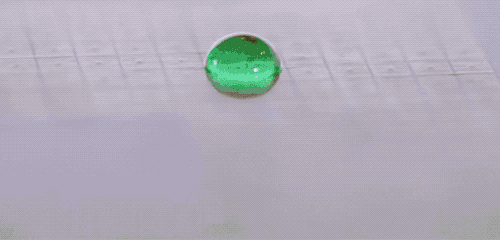Our lives are busy and full of distractions. Modern computing. with its constant notifications and enticing red bubbles next to apps, seems designed to keep us enthralled. MIT Media Lab’s Tangible Media Group wants to change that by crafting “calm interfaces.”
The Tangible Media Group demonstrated a way to precisely transport droplets of liquid across a surface back in January, which it called “programmable droplets.” The system is essentially just a printed circuit board, coated with a low-friction material, with a grid of copper wiring on top. By programmatically controlling the electric field of the grid, the team is able to change the shape of polarizable liquid droplets and move them around the surface. The precise control is such that droplets can be both merged and split.
Moving on from the underlying technology, the team is now focused on showing how we might leverage the system to create, play and communicate through natural materials.
“Water is a natural material that exhibits interesting phenomenon like bending light … It has the ability to merge, it happens naturally,” Udayan Umapathi said. A designer, engineer and experimental physicist, Umapathi is a researcher at MIT Media Lab, where he leads development on programmable droplets. “When we looked at various scenarios where you interact with water physically, and water has some physical information, a concrete example that stood out was an artist painting color.”
The first use-case for programmable droplets, then, is a kind of automated painters’ palette. An artist takes a photo on their phone, selects the object they’re focused on, and then sends a signal to the palette to mix various colors to recreate the hue they’re interested in. “In this specific use-case, the information the droplets carry is the color itself … The technology is integrated into a compact, real-world object.” Umapathi said.

Computationally reconfigurable materials, or “Radical Atoms” in MIT parlance, have long been a focus of the Tangible Media Group, and this latest project explores the subject through a new lens. By moving droplets precisely around a “leaf,” the team is able to tap into two natural properties of water: its ability to apply force and its ability to, well, make things wet. Umapathi explained that you could also “program the sequence by which water develops onto various petals” to control the way a flower blooms.

Umapathi generously describes the third project as a “gaming console,” but it’s better described as a single game. As you probably could’ve guessed, it revolves around water. You control a droplet by gently tilting the device to move it around a small tray. Your objective is to absorb the other droplets in the tray, which are controlled by a computer. It plays out something like Pac-Man, or perhaps more accurately Osmos.

The demonstration ends with something a little more conceptual, but potentially a lot more exciting. It shows a person leaving their house in the morning as they pause to send a message to their partner. As they click okay on their message (“Have a nice day <3”), the camera cuts to their partner brushing their teeth. In the fogged-up mirror of the bathroom, we see the message rendered in droplets.

“If you look around, there are water droplets around you, for example rain, or water condensing to droplets on umbrellas and cups,” Umapathi explained. “We’re working on a transparent programmable droplets display, so in this scenario what we’re illustration is that the droplets that are already present in your environment can be harnessed and used as an interface.”
The team does have a fully-working transparent display that can be used to display messages like this, Umapathi said, but it’s not quite developed to the point where it could be seamlessly mounted on a mirror.
It’s important to project forward like this, though. The conceptual scenario is definitely the strongest demonstration of the technology, and the easiest to see being integrated into our day-to-day lives. Umapathi says the team is “at least a year” from a working prototype of the mirror concept, but it’s clear that, unlike many concepts we see, this one is clearly grounded in the realm of possibility.
The Tangible Media Group is due to show off its work this week at the Association for Computing Machinery’s Conference on Human Factors in Computing Systems, which is thankfully abbreviated to “CHI 2018.” Following the conference, the team will continue to work on developing its programmable droplets, hopefully working towards bigger and bolder concepts in the future.
In addition to crafting its own concepts, the team has also put its technology in the hands of designers, in the hope of inspiring them to come up with new ways to use it. Umapathi detailed one designer’s idea to create a “micro cocktail machine.” By placing various liquids onto the surface, it would be possible to blend them precisely to make tiny alcoholic beverages. While it’s perhaps the idea with the least societal value, if MIT put its device in the right bar, they could probably make millions charging $5 for a drop of the perfect martini.
from Engadget https://engt.co/2qV7IQp
via IFTTT

